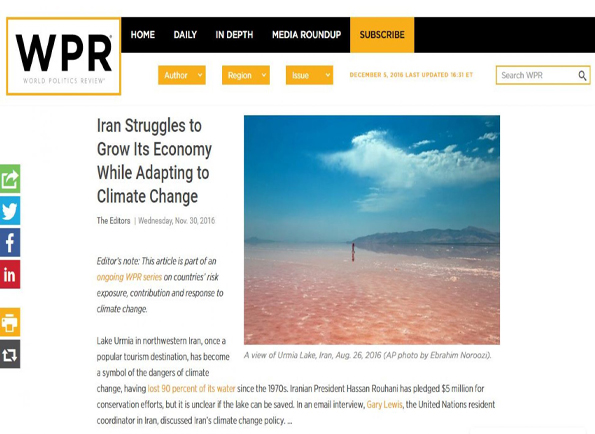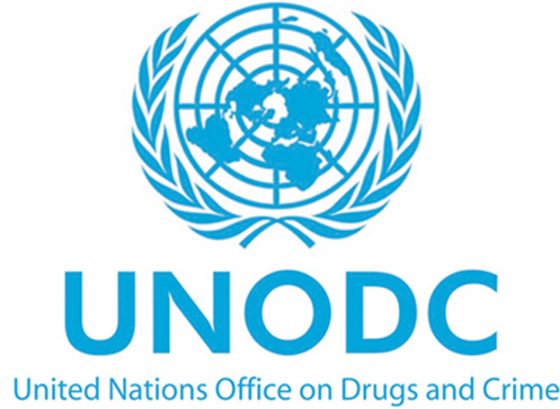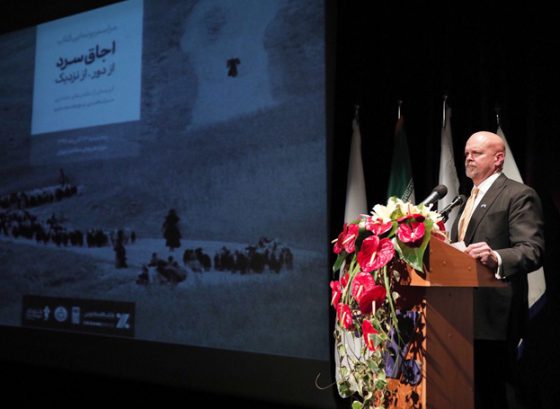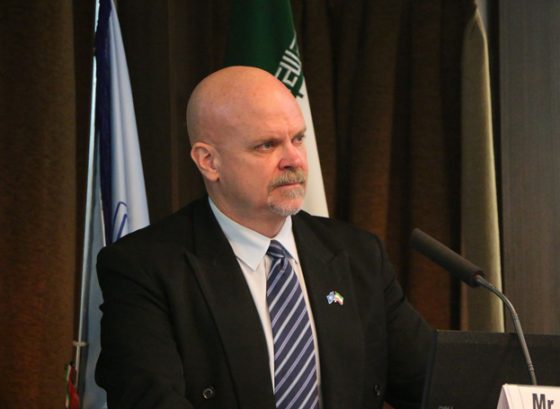World Politics Review interview with UN Resident Coordinator in Iran

The World Politics Review recently published an interview with the UN Resident Coordinator in the Islamic Republic of Iran, Mr. Gary Lewis. The topic of the interview was climate change, AVA Diplomatic reports.
Below you can read the full text of the interview:
WPR: What impact will mitigation efforts, both within Iran and abroad, have on Iran’s energy sector and development potential?
Gary Lewis: The energy sector in Iran has focused its efforts primarily on meeting rapidly expanding demand. But, as part of its Paris Agreement commitment, Iran has pledged to reduce its greenhouse gas output by 4 percent. This figure will increase to 12 percent if all sanctions are removed. Yet, in order to generate economic growth, Iran will need to increase its production of oil and natural gas, which is difficult given the industry’s aging infrastructure.
So the question now becomes whether Iran can increase the amount of renewables in its energy mix in order to meet its commitments under the Paris Agreement on climate change, while diminishing its reliance on hydrocarbons, and at the same time generating economic growth.
In the long term, switching to low-carbon technologies can bring enormous benefits, such as increased employment, energy security, rural development, and health improvements through reduced air and water pollution. But this will take time. This will be a difficult circle to square given the need to deliver the sort of growth that has not materialized following the Nuclear Deal.
WPR: What is Iran’s risk exposure to climate change, what effects of climate change are already apparent, and what sorts of adaptation approaches will it have to adopt?
Lewis: Iran faces climate change-related challenges from extreme weather events including sand storms, dust storms and droughts, water pollution, land degradation and desertification and air pollution On top of man-made problems, such as the construction of dams and the massive over-pumping of ancient aquifers, climate change will worsen the prevailing water shortages in Iran. There is already social tension sover the allocation of water resources in parts of the countryside. Some climate change models predict lower rainfall overall, particularly in areas that currently produce much of Iran’s food. Climate change will also bring higher temperatures, leading to more water loss by evaporation. This will not only affect water availability, but also food production.
The threat of land degradation, including desertification is increasing. While it is true that desertification is being driven by climate change trends, it is mainly being driven by population pressure, including the over use of water and overgrazing. As a result, land is becoming less productive at the very time when Iran needs to increase its production to ensure sufficient food for its growing population. Iran needs stricter policies and laws to protect land and water resources, and existing laws need to be better enforced.
Air pollution is another threat. Some of Iran’s cities are among the most polluted in the world. Earlier this month, authorities in Tehran closed schools and placed restrictions on traffic because of dangerous levels of pollution in the atmosphere. The sand and dust storms affecting Iran have grown both in number and severity over the past decade. Solutions to these air pollution problems must include regulating energy pricing, limiting vehicle exhaust emissions, better policy enforcement and increased regional cooperation.
The mitigate the effects of these threats, Iran needs to increase low-carbon electrification, cut emissions from fossil fuel extraction and conversion, increasing the use of renewable energy, improve energy transmission and distribution efficiency, and reduce energy demand.
WPR: How big of an issue is climate change domestically, what steps has Iran already taken to reduce its carbon footprint, and what further commitments has it made in the context of the Paris Agreement?
Lewis: Iran is signatory to the Paris Agreement, which sets the objective of curbing global warming to well below two degrees Celsius above pre-industrial levels. The most sustainable way of doing this is by moving to clean energy. Iran’s existing power generation capacity stands at 74,000 MW. But only around 200 MW of this is currently produced through renewable sources.
Regarding water, it is useful to look at what Iran is currently trying to do in Lake Urmia. That lake used to be one of the largest hyper-saline wetlands in the world. However, over the past 20 years, aggressive farming has diverted river water from the lake, and now over 90 percent of its water has disappeared. This left a huge, empty, dusty salt bed that damages surrounding agricultural lands and harms people’s health.
With help from the United Nation, Iran is working with local farmers and government to initiate an adaptation process by implementing sustainable agriculture practices. With financial support from the Japanese government and the Iranian government, these practices have been successfully implemented in 90 villages. This is expected to “save” one-third of the water that would otherwise been used for farming, which can now flow back into the lake. This initiative is expanding to cover more villages, but even this would account for only 10 percent of the irrigated farming in the Urmia basin.
While Iran does not have an overall National Adaptation Plan as yet, there are several adaptation practices underway. The problem is time and resources. The government needs to accelerate the development of a realistic and applicable National Adaptation Plan while up-scaling current ongoing practices with the support of the private sector, international partners and the general public.
More than this, the public as a whole needs to understand what is at stake. For this, there needs to be more discussion and greater awareness. The real breakthrough will come when discussion on the impact of climate change goes beyond a discourse between the technocrats and policymakers. There needs to be better awareness of the effects and risks of climate change on the community level.




